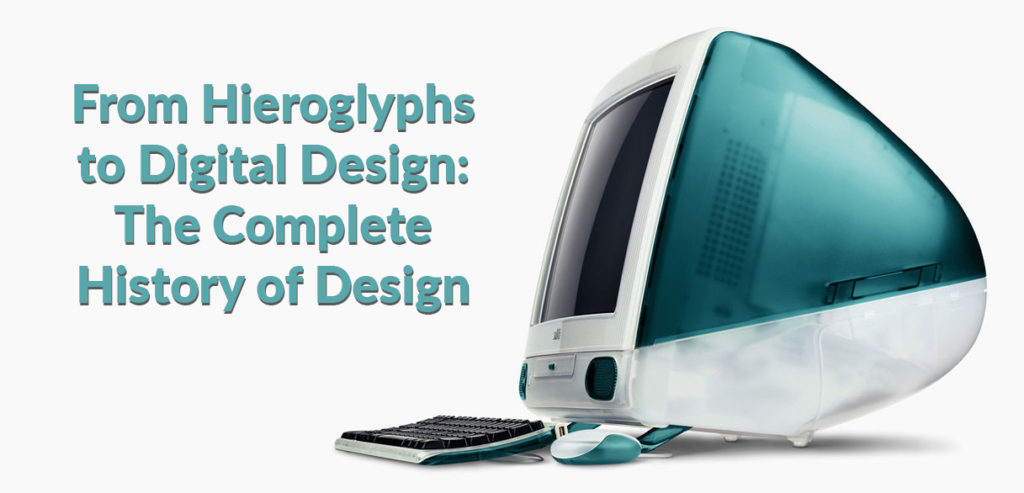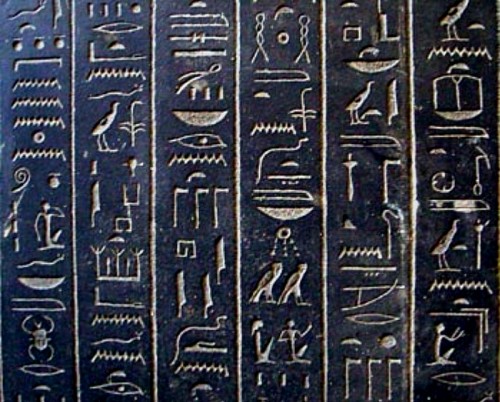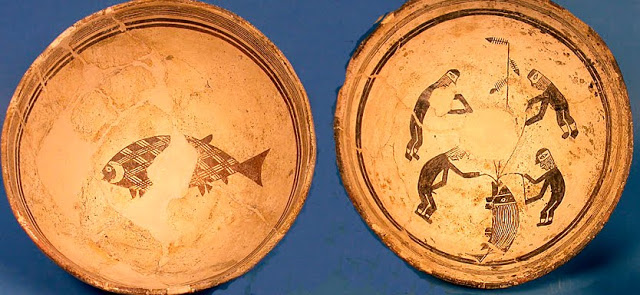
Although it may seem like graphic design is a very new field, it actually has roots as old as human culture. Here is the complete history of design, from rock art and hieroglyphs to digital design:
The Foundations of Graphic Arts Are Laid
In different places all over the world, primitive peoples laid the foundations of the graphic arts by painting animals in caves:
70000 BC: symbolic geometric designs are created of the iron ore stone ochre on the southern coast of Africa in the Blombos Cave.
30000 BC and earlier: Primitive humans create hundreds of graphic designs of animals in the Chauvet Cave, in the south of France.
17000 – 9000 BC: Various peoples create the bison paintings inside the Altamira caves of Spain.
14000 BC and earlier: Many animal designs similar to those in the Chauvet Cave are produced in the Lascaux cave, also in France.
8000 BC and earlier: People in Assyria, Cartage, Egypt, Mede, Persia, and Sumer created pottery to communicate aesthetic, cultural, ethical, religious, and socio-political information.
Writing Develops Into Visual Communication Design
Ancient Egypt gave birth to visual communication systems of hieroglyphs as characters forming the roots of calligraphy developed in China:

4000 – 3000 BC: Writing in hieroglyphs emerges in Ancient Egypt.
4000 BC: Chinese characters that form the basis of Chinese calligraphy are in use.
3000 BC: The pottery wheel is invented and characters are seen on pottery.
2300 BC: Ancient clay maps are in use in Babylonia.
2125 – 1991 BC: Grids appear in use in Egyptian designs, helping artists maintain ratios and proportions.
1435 – 1412 BC: Written inscriptions in ceramics from this time period exist in China.
Paper, Books, Textiles, and Other Technologies Seed Graphic Design Elements
The invention of paper leads to other new technologies and techniques:
100 AD: Paper is invented in China. An industry of papermaking began there in about 105 AD. It is later brought to Japan in about 610 AD.

100 – 800 AD: The Nazca culture in South America produces polychrome pottery with at least 15 colors which serves to communicate cultural ideas graphically.
250 – c. 1450 AD: Religious art, particularly the Byzantine art, was designed to communicate messages to its viewers as efficiently as possible using calligraphy, stylized images, and signs. In this sense it shares a great deal with its modern progeny, graphic design.
500 – 800 AD: The Book of Kells, an early religious text notable for its elaborate, complex illustrations and designs, was produced on manuscripts in monasteries in the UK.
600 AD: Porcelain is invented, and with it comes a far stronger sense of aesthetic design.
700 – 900 AD: Islamic calligraphy reaches its apex in many elaborately decorated versions of the Qur’an.
1000 AD: Playing cards, many with intricate and artistic designs, are in use throughout Asia by the 11th century.
1200 AD and onward: Graphic design techniques such as broken rules of proportionality and composition of elements in a certain shape to emphasize a central figure are seen in Chinese, Vietnamese, and Japanese art.
1200 – 1300 AD: The Dresden Codex, a complete illustrated Almanac of Mayan history and civilization, is published. It is one of few such texts to survive the destruction wrought by Spanish conquest.
1276 AD: Having been imported to Europe by Arab traders, paper is first made in Italy. It is made in England by about 1495 AD.
1300s AD: By this time many examples of heraldry such as coats of arms and the White Rose of York are in widespread use throughout Europe.
Late 1300s AD: Modern playing cards are introduced to Europe and are in wide use quickly. Tarot cards and their blending of religious and cultural traditions in graphic form are in use at about the same time.
1400 – 1600: Various Books of Hours are created; these are detailed, illuminated manuscripts that function as calendars and historical references.
1440: Johannes Gutenberg invents the printing press. This leads to more widespread literacy and production of printed materials.
1450 – 1530 AD: The Inca Empire values textiles highly and graphic design is expressed through clothing which features rich patterns, colors, and storytelling designs.
1543: Copernicus maps the sky in visual form.
1582: Saliba’s map of the cosmos blends Renaissance experiences and beliefs with ancient Pagan and medieval Christian cosmology in an aesthetically beautiful work.
1782: After declaring independence, the United States of America designs its logo and the seal is approved. Each detail of the design has a specific meaning and is part of the approval process.
1800s: The printing press begins to be built with iron and powered by steam, leading to mass production of printed materials. By the end of the century, cell animation and animation from photographs has been produced.
1840: Chromolithography emerges in the US, making printed colored posters and labels a common sight.
The Modern Era Begins

1885: Frank Mason Robinson designs the Coca-Cola logo.
1890 – 1910: The Art Nouveau movement flourishes in Europe and the US, giving rise to detailed, colorful posters and other artwork.
1891: William Morris founded the Kelmscott Press near Oxford and with it helps usher in an era of art books, typography, and layout.
1910 – 1913: Commercial logos become common.
1914: Pierre de Coubertin designs the Olympic flag.
1915: Russian painter Kazimir Malevich creates the first in his “Black Square” series, which goes on to become a modernist symbol.
1917: The Dutch De Stijl or “the style” movement is organized by painter Theo van Doesburg, and becomes home to Dutch architects, artists, and designers including Piet Mondrian. The movement emphasizes simplicity and abstraction.
1920 – 1921: Minimalism is introduced to the world by Dutch painter Piet Mondrian.
1921: The International System of Typographic Picture Education or ISOTYPE, then called the Viennese method, is introduced by social scientist Otto Neurath. This starts the practice of basing design decisions in part on scientific data.
1918 – 1933: The Bauhaus school of design gains prominence throughout the Western world until it is closed in Nazi Germany. The Bauhaus style emphasized technical function and industrial design alongside aesthetic sensibility and omitted flowery facades as homage to the machine age.
1930s: Art Deco becomes the most prominent school of design in the US. Industrial design is also born during the time and begins to grow more important in the US as artists like Raymond Loewy gain traction with their designs.
1950s: Early experiments such as the SAGE and Whirlwind projects introduced the cathode ray tube as a viable interaction interface and display and introduced the light pen as an input device. These advances would serve as a precursor to digital design tools.
1956: Paul Rand designs the pictographic IBM logo which features the human eye and the bee.
1958: British artist Gerald Holtom designs the peace symbol.
1960s: Rooted in the works of Braque, Malevich, Picasso, and Warhol, the American minimalist movement begins as a backlash against Abstract Expressionism. Psychedelic design also comes onto the scene, and the phrase “computer graphics” comes into use.
1962: Thought leaders among art directors and graphic designers in London including David Bailey, Alan Fletcher, Terence Donovan, and Colin Forbes found D&AD, Design and Art Direction. The group is intended to promote excellence in advertising and design.
1962 – 1964: A. Michael Noll and Charles Csuri create some of the first computer art.
1972: Pentagram, one of the most prominent design studios in the world, is founded.
1973: Pink Floyd released Dark Side of the Moon with one of the most iconic album covers in history.
1977: New York State Department of Commerce recruits Milton Glaser for its marketing campaign, leading to the iconic I heart NY pictogram.
1981 – 1986: Neville Brody designs world-famous covers for The Face, changing the look of magazine design, typography, and page layout.
1992: David Carson shifts typographical design into the 90s with his work at Raygun, an indie rock magazine.
1994: Lindon Leader designs the FedEx logo to include a “hidden” arrow. The logo goes on to be ranked one of the best in years.
The Digital Age Begins
1970s: CGI is developed throughout the decade. CAD technology develops and is put into use.
1972: Steve Jobs drops out of college and drops into a calligraphy class that later provides the foundations for the Mac’s typography.
1985: The music video for “Money for Nothing” by Dire Straits becomes a ground-breaking example of animated 3D computer-generated imagery.
1986: Steve Jobs joins Pixar which goes on to release its first feature length movie, Toy Story, in 1995.
1990s: 3D modeling appears in widespread use. Rendered 3D graphics appear photorealistic to untrained eyes. Real-time 3D graphics appear in video games.
1998: iMac comes out in a rainbow of colors, shaking both the design and computer industries.
1999: MyFonts launches as a one stop shop for fonts created anywhere by anyone.
2000: FontLab Studio becomes the most commonly used font package in design.
2000s: CGI is in widespread use and can be found in commercials, movies, television shows, and games.
2002 – 2003: Adobe makes InDesign Mac-native bound, and bundled it with Photoshop in 2003, making the Creative Suite the major (if not the only) designer’s game in town.
2005: Adobe takes over Macromedia and its products Dreamweaver, Flash, and FreeHand.
2008: Shepard Fairey creates the “Hope” design for the Obama campaign.
2016: Pokemon Go uses AR in an app and everyday businesses join in for advertising purposes; AR has become for more common, and interactive UX has become an essential design consideration.
Conclusion
One of the most exciting things about the complete history of graphic design is that despite its long, deep roots, so much remains unwritten. This core element of human culture continues to change at a rapid pace, and we can expect to see many more innovative riffs on our fascinating shared history.